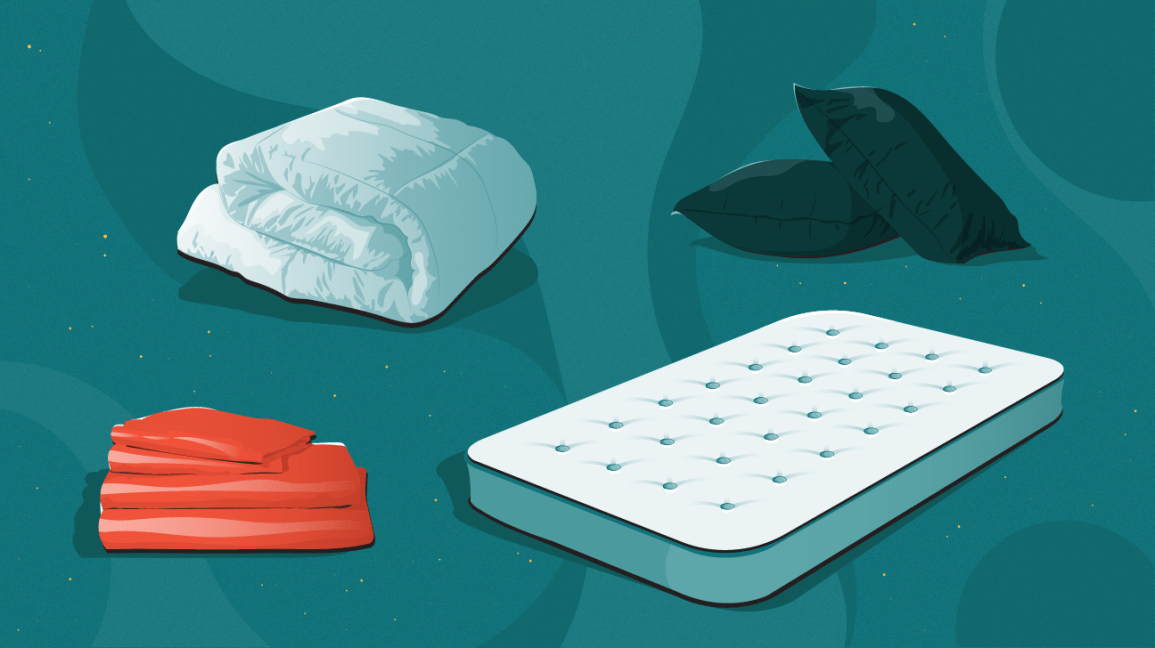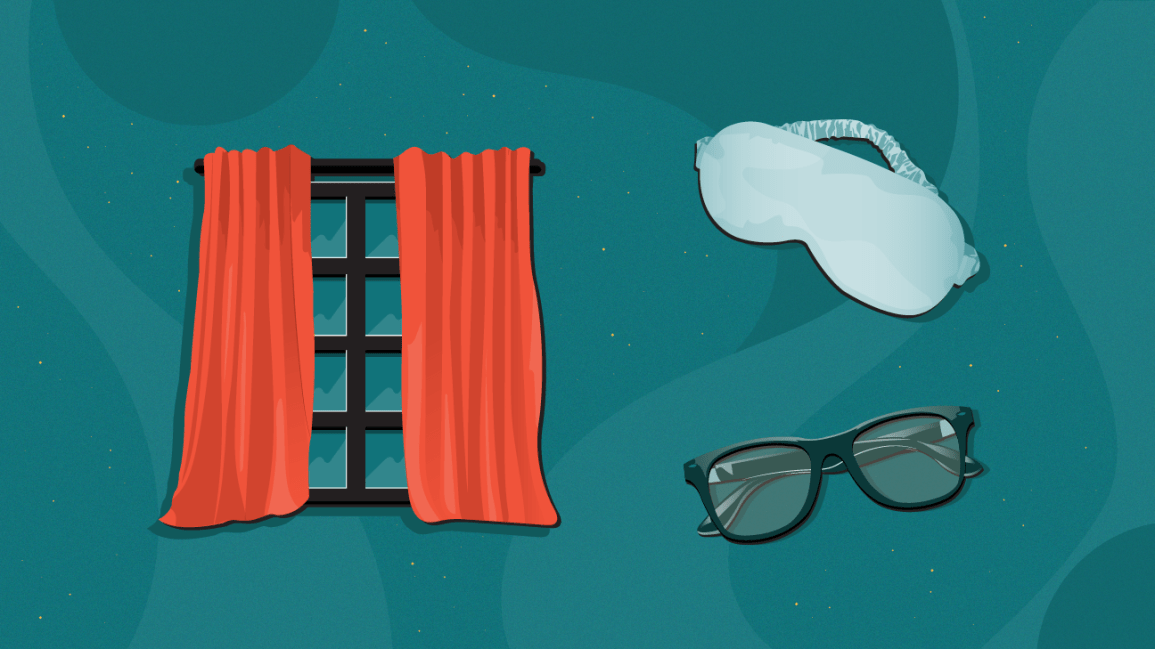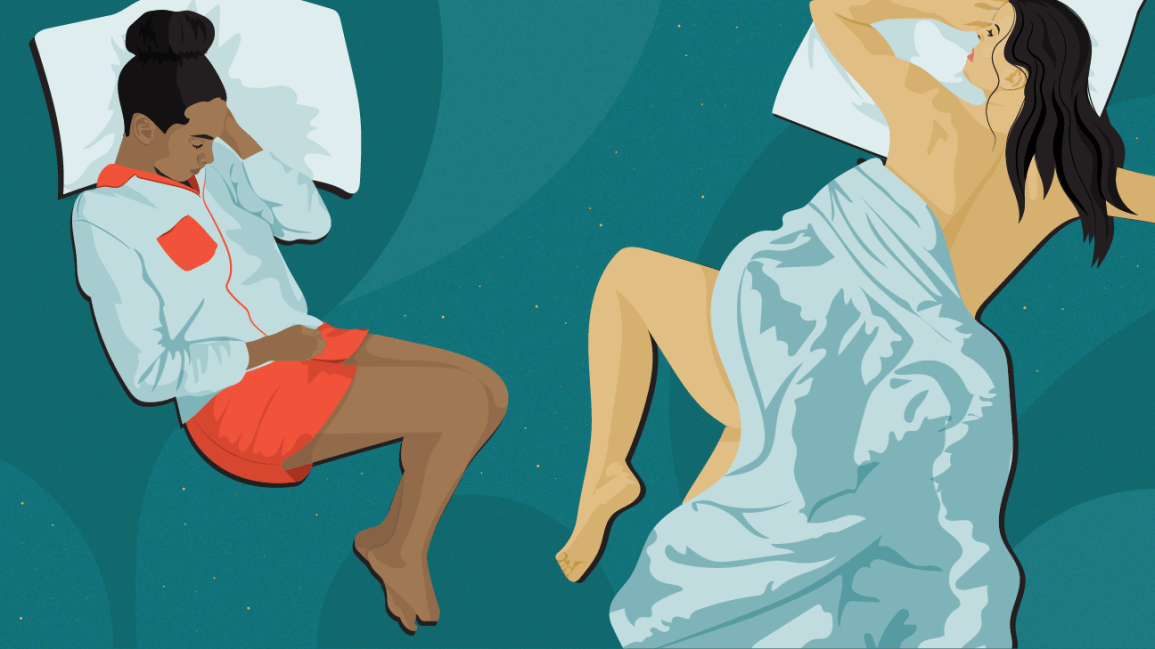When it comes to bedroom design, many people focus on elements that reflect their needs when they’re awake.
Clothes on the chair? Easier to grab in the morning. Cluttered furniture? You need your bed, desk, dresser, and chair. Overflowing laundry hamper? With everything you have to do, laundry is pretty low on your priority list.
You also keep your computer and phone close at hand, since you never know when you might need them. You try to avoid looking at them after you turn off the lights, but your resolve doesn’t always stick — especially when you have trouble falling asleep.
Your bedroom might offer convenience by day, but there’s a chance it has a different impact at night. Even if all you do is sleep in your bedroom, you still spend about a third of each day there. A hot, bright, cluttered room can disrupt your sleep and keep you lying awake for a chunk of this time, which can mean bad news for your waking health.
But, here’s the good news: Updating your bedroom can help you get better sleep, which can, in turn, improve overall well-being. Our guide below can help you get started.
Many people decorate their bedrooms to appeal to their waking senses. This might mean bright colors, fun paintings, plenty of sunshine, and strong light that lets you get your work done.
The most important activity that takes place in your bedroom, however, is sleep. When you don’t get enough sleepTrusted Source, your brain and body don’t get a chance to rest, recharge, and carry out the essential processes that keep you functioning as you should.
The amount of time you spend sleeping matters, yes, but so does the quality of that sleep. If you spend 4 of your 8 hours in bed tossing and turning, you might not feel very rested the next day.
Making a few changes can help you create a more comfortable sleep environment. According to sleep experts at Johns Hopkins, the following bedroom features can make a big difference in the quality of your sleep:
- Temperature. A cooler room and bed can reduce nighttime sweating and improve sleep. Aim to keep your bedroom thermostat set to 65°F, give or take a few degrees.
- Light. Bright blue lightTrusted Source, be it from the sun or electronics, can disrupt sleep. Putting down your devices, using blackout curtains, and using very dim lights at night can improve your rest.
- Pets. You can love your furry friends without loving their nighttime commotion. If you’re unable to get good sleep with a restless pet, consider keeping them off the bed.
- Tidiness. You may not see your bedroom clutter while you sleep, but it could still have an impact on your rest. For better sleep, try tidying up and making your bed each day.
Wondering whether it might be time for a bedroom upgrade? We’ve got more detailed tips and product recommendations below.

Bedding, including sheets, blankets, pillows, and your mattress, can have a pretty big impact on sleep. If your bedding is old, worn-out, or in a state that prevents you from maintaining an ideal sleep temperatureTrusted Source, you may not feel great in bed.
Quality bedding doesn’t have to cost a bundle, but it should feel comfortable. Who wants to crawl into bed and pull up the same scratchy sheets, or nestle under blankets that are too thin, too heavy, or falling apart? Probably not you. Better bedding doesn’t just improve your rest, it can also make bedtime more inviting.
Sheets and comforter
Everyone has a different preference in sheets, so you’ll want to look for sheets that feel comfortable to you. There are many types of cotton sheets, from light and airy percale to smooth sateen. You might also prefer the feel of super soft and stretchable jersey knit.
Take a trip to your local department store to give different types of sheets a touch test. Not all brands have the exact same feel, but this can give you a better idea of what fabrics you prefer.
Look for natural fabrics, including cotton, silk, bamboo, or linen, if you sleep on the warmer side. Polyester and other synthetic sheets can trap heat, leaving you sticky and sweaty.
A few sheet sets to consider:
- Simply Vera Vera Wang Supima Cotton 600 Thread Count Sheet Set. This writer’s favorite sheets come in muted shades to inspire dreamier sleep. They feel cool and cozy at the same time and get a little softer with each wash.
- Ettitude Bamboo Lyocell Sheet Set. The sustainable bamboo fabric used in these breathable sheets is intended to give them a smooth, soft feel. They’re great for sensitive skin, warm sleepers, and people looking to sleep greener.
- Tuft & Needle Jersey Sheet Set. Love sleeping in your favorite T-shirt? Treat your whole body to the same comfort by cuddling in jersey sheets. Tuft & Needle’s jersey set blends cotton and lyocell for breathability and comfort.
Options for your top layer:
- The Buffy Breeze. If you’re a hot sleeper, a cooling comforter, like this sustainable eucalyptus option, can help you stay warm without overheating.
- Layla Weighted Blanket. Anxious feelings keeping you up at night? A weighted blanket, like this washable plush option, may help reduce anxietyTrusted Source.
Pillows
The place you rest your head matters, and the wrong pillow can keep you up at night. You treat your head with care during the day, so it makes sense that you’d want to give it the same consideration while you sleep.
A good pillow should support the curve of your neckTrusted Source to keep your spine aligned during sleep. You’ll also want to consider your regular sleeping position. Side sleepers may rest more comfortably on firmer, fuller pillows. Thin, soft pillows will help stomach sleepers maintain good spinal alignment. And a medium firmness might work best if you sleep on your back.
Of course, if you’re sleeping on yellowed, stained, or flat pillows — or ones with a strange smell — it’s time to toss them and bring in something new.
A few pillows to check out:
- Coop Home Goods The Original. This shredded memory foam pillow works for all sleeping positions. You can add or remove filling to get just the right height.
- Check out more pillows to consider for back sleepers, side sleepers, stomach sleepers, or people with neck pain.
Mattress
An old mattress, or the wrong one for your sleeping position, can contribute to nighttime pain and discomfortTrusted Source.
While you might think you’d get the best sleep on the softest mattress, that’s actually not the case for most people. Side sleepers might benefit from the pressure relief offered by softer foam mattresses, but researchTrusted Source suggests a medium-firm mattress is a good option for most people looking to improve sleep quality and comfort. If you only sleep on your stomach or back, you might even want to go a little firmer.
According to the Better Sleep Council, it’s wise to replace your mattress once it passes the ripe old age of 7 years, though some higher-quality mattresses may last a little longer. Aim to replace it sooner rather than later if you can feel the springs, regularly wake with pain or stiffness, or dread the thought of spending another night on top of it.
Ready to shop for a new mattress?
- Tuft & Needle Original Mattress. This basic foam mattress comes highly rated, and its medium-firm feel is designed to meet the needs of most sleepers.
- Check out more mattress options for back sleepers, side sleepers, stomach sleepers, combination sleepers, and people with back pain.

Natural light has plenty of benefits, but these go out the window when it comes to restful sleep.
Any bright light can disrupt your circadian rhythmTrusted Source and impact your levels of melatonin, the hormone that helps you feel tired and signals bedtime.
Depending on your schedule, you might go to bed before the sun fully sets or wake up well after daybreak. This means daylight could wake you before you intend on getting up.
But the lights inside your room can have an impact, too. Turning on bright overhead lights or lamps in the evening and using them right up until bedtime can also suppress melatonin, keep your body in “awake mode,” and potentially prevent you from falling asleep.
One good solution might involve dimming the lights. If you need bright light to work and you don’t have another room to use, consider buying a table lamp with a warm amber bulbTrusted Source. As soon as you put your work away for the night, turn off the overhead light and keep the lights low.
Blackout curtains
Heavy, room-darkening shades or curtains can help you make the most of sunlight during the day and block it out when you need to sleep.
Bonus: Blackout curtains could also help lower your energy bills.
- Wayfair Basics Solid Blackout Grommet Single Curtain Panel. These basic curtains help reduce both noise and light, and they come in an array of colors to better suit your bedroom decor.
Sleep masks
Can’t block out all the light? A sleep mask can help save your shut-eye. Sleep masks infused with lavender may even help you relax at the same time.
- Ettitude Bamboo Lyocell Eye Mask. This hypoallergenic organic bamboo mask gently blocks light while resting easy on your skin.
- Kitsch The Lavender Weighted Satin Eye Mask. Dried lavender adds a calming scent to this sleep mask, while microbeads give it a bit of weight to help ease tension.
- Blue light glasses
Knowing that turning off devices before bedtime helps reduce exposure to blue lightTrusted Source is one thing. Actually following through is quite another.
Perhaps you work through the evening or use the nighttime hours to catch up on news and chatting with friends. In short, not everyone can switch off at night. Anti-blue light glasses can help reduce your exposure to blue light when you’re having trouble turning off screens entirely.
While more research is needed to know exactly how these glasses affect sleep, a small 2014 study found that blue light blocking glasses reduced LED-induced melatonin suppression in adolescents.
So, while it may be ideal to turn off these screens entirely before bed, we also know it might be a hard habit to break. Using a pair of blue light-blocking glasses can be a good compromise as you perfect your sleep routine.
- 4EST Shades Blue Light Blocking Glasses. These eco-friendly glasses are designed to block up to 97 percent of blue light from screens. For each pair purchased, the company plants two trees.

If you’re a light sleeper, you probably know just how much small sounds can disrupt your sleep. Noises from outside your bedroom (or a snoring partner next to you) can keep you lying awake, worrying about lost rest.
Sound solutions, such as earplugs, white noise machines, or sleep headphones, can help you get back to snoozing instead of tossing and turning or jolting awake whenever a car door slams.
If you’d rather not sleep with earplugs, consider these alternate methods of blocking out distracting sounds:
- Yogasleep Travel Mini Sound Machine. This simple sound machine from Yogasleep has six different sound options, from classic white noise to a gentle surf and a thunderstorm. It also features a soft amber light. You won’t need batteries, either, since it charges with a micro USB cable.
- HIGHEVER Sleep Headphones. These noise-cancelling headphones let you play your own soothing sounds or white noise playlists (try the myNoise app) while also blocking out some outside noise. The headband structure keeps the speakers in place, so you won’t have to worry about them slipping off your ears when you turn over.
- Check out more options for white noise machines and headphones for sleep.

You might not put quite as much thought into your pajamas as you do with the clothes you wear each day, but your sleepwear still deserves some consideration.
The best pajamas should feel soft on your skin, and they should be warm enough to keep you cozy, but breathable enough to keep you cool and dry.
It goes without saying that tight waistbands, cuffs, collars, and rough fabrics might not promote restful sleep. The best suit of pajamas, in fact, may be your birthday suit.
- Learn more about the benefits of sleeping naked.
With so many potential changes to consider, you might feel just a little overwhelmed right about now. What should you do first to make your bedroom a more restful place?
Well, that largely depends on you.
A good first step is to take stock of your current sleep habits. Have you noticed anything specific keeping you awake?
You might have a noisy neighbor or a bird’s nest just outside your window. Maybe you’ve meant to update your bedding for, well, years. Start there, and see how your sleep improves. You don’t necessarily need to toss your entire room.
On the other hand, you might feel ready to do a complete bedroom revamp, perhaps even refresh your walls with a more sleep-friendly color (Tip: Go for muted shades of blue, green, or yellow.)
Take some time to look into the best options for you. You’ll find plenty of mattresses, sheets, and pillows on the market, so investing in the right ones can help you get more quality rest for years to come. When choosing a new mattress, you’ll also want to consider things like your sleeping position and temperature regulation needs.
Considering a brand-new bed? If you’re short on space, why not change up your room with a loft bed or a bed with storage drawers? These options work well for preventing clutter in small spaces (and, yes, they come in adult sizes).
Low-cost room upgrades
A room revamp can get a bit pricey, and you may not have room in your budget for a new bed or mattress.
These tips can give you ideas for smaller changes that still make a difference:
- Bring out your fan. A fan can be a cheap option for blocking disruptive noise and keeping you cooler through the night.
- Wash your sheets and blankets. Keeping fresh sheets on your bed can make bedtime more appealing. Snuggling in freshly washed sheets really does feel different.
- Make your bed. When you wake up, make your bed. It may not seem like much, but it can change the feel of your room and give it a more put-together look.
- Declutter. While we’re on the topic of tidy rooms, a 2010 studyTrusted Source found that participants who described their homes as cluttered felt more stressed while at home. Sound familiar? If you’re looking for ways to make your home more relaxing, consider clearing out the clutter in your bedroom. Put away anything on the floor to promote both tidiness and safety. Clean desk drawers can make it easier to work, and a cheap swath of fabric can freshen up dresser or bookshelf tops. Hanging organizers or storage drawers also make great affordable tidying solutions.
- Move some furniture. Does your room feel cramped or slightly off? Consider moving things around to create an open, peaceful environment. These bedroom feng shui tips can get you started.
- Consider your senses. Sleeping in a room that smells odd or feels stuffy may not be particularly pleasant. Cracking the window for an hour or so each day (or longer when you have nice weather) can refresh the air and your mood. A reed diffuser with essential oils can also add a touch of fragrance. Your preferred oil may also have other benefits: maybe it’s uplifting, calming, or relaxing.
Now, all you need is a good bedtime routine.
You may not spend many of your waking hours in your bedroom, but it should still be a haven of sorts.
Sleep renews you and prepares you for another day, and you’re more likely to get the quality, restorative rest you need in a calm, clean environment.
The best part? You don’t have to break the bank to create that restful space.